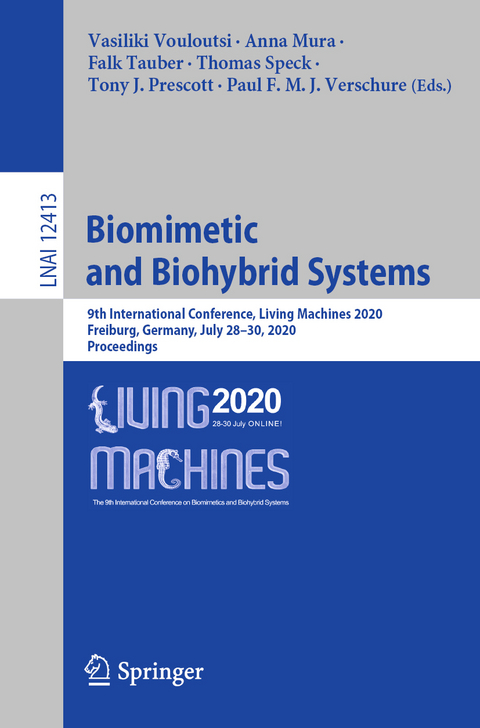
Biomimetic and Biohybrid Systems
Springer International Publishing (Verlag)
978-3-030-64312-6 (ISBN)
Improving recall in an associative neural network model of the hippocampus.- Iterative Learning Control as a Framework for Human-Inspired Control with Bio-Mimetic Actuators.- Efficient fine-grained object detection for robot-assisted WEEE disassembly.- Integrated Topological Planning and Scheduling for Orchestrating Large Human-Robot Collaborative Teams.- Programming Material Intelligence: An Additive Fabrication Strategy for Self-Shaping Biohybrid Components.- Multi-material 3D-printer for rapid prototyping of bio-inspired soft robotic elements.- Kinematic and Kinetic Analysis of a Biomechanical Model of Rat Hind Limb with Biarticular Muscle.- How to reduce computation time while sparing performance during robot navigation? A neuro-inspired architecture for autonomous shifting between model-based and model-free learning.- An Image-based Method for the Morphological Analysis of Tendrils with 2D Piece-wise Clothoid Approximation Model.- Cholinergic control of chaos and evidence sensitivity in a neocortical model of perceptual decision-making.- Biomechanical Characterization of Hook-Climber Stems for Soft Robotic Applications.- Machine Morality. From Harm Avoidance to Human-Robot Cooperation. Haptic Object Identification for Advanced Manipulation Skills.- Distributed Adaptive Control: An ideal Cognitive Ar-chitecture candidate for managing a robotic recycling plant.- Standing on the water: stability mechanisms of snakes on free surface.- From models of cognition to robot control and back using spiking neural networks.- A framework for resolving motivational conflict via attractor dynamics.- Insect inspired view based navigation exploiting temporal information.- Split-belt Adaptation Model of a Decerebrate Cat Using a Quadruped Robot with Learning.- Biohybrid wind energy generators based on living plants.- Snapshot Navigation In The Wavelet Domain.- Bioinspired Navigation Based on Distributed Sensing in the Leech.- A plausible mechanism for Drosophila Larvaintermittent behaviour.- Robophysical modeling of bilaterally activated and soft limbless locomotors.- Fast Reverse Replays of Recent Spatiotemporal Trajectories in a Robotic Hippocampal Model.- Using Animatlab for Neuromechanical Analysis: Linear Hill Parameter Calculation.- Spatio-temporal Memory for Navigation in a Mushroom Body Model.
| Erscheinungsdatum | 25.12.2020 |
|---|---|
| Reihe/Serie | Lecture Notes in Artificial Intelligence | Lecture Notes in Computer Science |
| Zusatzinfo | XVI, 428 p. 18 illus. |
| Verlagsort | Cham |
| Sprache | englisch |
| Maße | 155 x 235 mm |
| Gewicht | 670 g |
| Themenwelt | Mathematik / Informatik ► Informatik ► Netzwerke |
| Informatik ► Theorie / Studium ► Künstliche Intelligenz / Robotik | |
| Informatik ► Weitere Themen ► Hardware | |
| Schlagworte | Applications • Artificial Intelligence • Bio-inspired Materials • Biomimetics • Computer Science • computer vision • conference proceedings • Drosophila • Human-Robot Interaction • Image Processing • Informatics • insect navigation • intelligent robots • Locomotion • machine learning • Mobile Robots • Research • Robotic Systems • robots • sensors • Signal Processing • snake robot • Soft Robotics • synthetic nervous system • Visual homing |
| ISBN-10 | 3-030-64312-3 / 3030643123 |
| ISBN-13 | 978-3-030-64312-6 / 9783030643126 |
| Zustand | Neuware |
| Haben Sie eine Frage zum Produkt? |
aus dem Bereich


